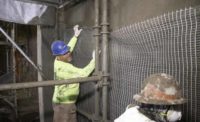The building-construction industry is constantly searching for new roofing products and system designs that can withstand the extreme weather conditions associated with hurricane-force winds.
Because of the extreme weather conditions in south Florida, stringent code compliance is required in certain areas of Miami-Dade County. Besides improving safety standards resulting from complying with codes, the development of wind-resistant products improves industry products in general because architects have more options when designing roofing systems that economically meet high levels of quality and performance.
The adoption into local building codes of standards such as ASTM E 1592—Standard Test Method for Structural Performance of Sheet Metal Roof and Siding Systems by Uniform Static Air Pressure Difference; UL 580—Tests for Uplift Resistance of Roof Assemblies; and TAS 125-03—Standard Requirements for Metal Roofing Systems have motivated and consequently resulted in many design improvements.
The relationship between building design, standards and architectural testing motivates manufacturers to bring better products to market faster. It drives the development of economical products that meet high standards of performance. Architectural testing is not only done to comply with local building codes but to develop new products.
This interplay between the testing of roofing systems and new product development has resulted in more widespread use of metal roofing. These roofs have been steadily gaining market share nationally and are increasingly being used in hurricane prone areas. There are many designs of metal roofing panels and methods for fastening them to the roof decks and purlins. If a metal roof can be built to withstand the high winds of a hurricane then a long service life is assured.
The Proof Is in the Testing
Competition is fierce in this growing segment of the roofing industry. If a contractor can demonstrate that a roofing system is in compliance with the performance requirements of Miami-Dade County, then his customers, building owners and insurance companies can rest assured that they are recommending a superior class of roofing system.
Naturally, one must consider various pros and cons when comparing the costs of materials, installations costs and the suitability of the roofing system for any application. One manufacturer may work out precisely where to add structural supports to withstand hurricane force winds, and yet the design may not look as robust as another bulkier and more costly design.
One should construct a roofing system as strong as possible without overburdening it with unnecessary design components or installation requirements.
One of the most useful tests for isolating design flaws is UL 580. This standard defines classes of roofing systems depending on the results of the testing. The classes are Class 30, Class 60 and Class 90. An engineer of record will typically specify the class required to meet the local building codes as they apply to the exact location of the building, the geometry of the structure and the local surroundings. Uplift pressure on roofing depends on many factors, including wind velocity, the location of the structure, roof slope, shape and height. Design professionals utilize ASCE 7-10 to determine the proper wind load design pressures of a building.
Through testing, a manufacturer may discover that minor modifications of a Class 60 roof could enable the roof to qualify as a Class 90 roof with only a slight increase in the cost of labor or materials. Conversely, a manufacturer may discover that a large saving could be realized by removing certain unnecessary design elements without affecting a Class 90 rating.
Testing of Non-Structural Roof Assemblies
To appreciate the tradeoff between design and testing, understanding how the tests are conducted and what they measure is important. For details, the reader should refer to the original standards.
Non-Structural Testing applies to roof panels installed over an independent structural roof deck such as plywood, B-deck or B-deck with ISO. The UL 580 and UL 1897 test methods are utilized to determine the uplift capacity of not only the metal panel itself but for the attachment to support and roof covering materials if used.
Intertek, one of the largest global testing and certification agencies with labs throughout North America, tests non-structural roofs inside a 10-foot by 10-foot UL 580 chamber designed to simulate roof uplift conditions. The chamber produces both steady positive pressure on the underside of the test assembly and steady oscillating negative suction-like uplift pressures upon the top surface. UL 580 consists of three classes: Class 30, 60 and 90.
UL Class 30 qualifies the roof for a design pressure of 45 psf; UL Class 60 for 75 psf; and UL Class 90 qualifies the roof for a design pressure of 105 psf, including 48.5 psf positive from below and 56.5 psf negative pressure (or vacuum) from above. A non-structural roof deck must have a minimum of a Class 90 rating to be installed in Miami-Dade County.
An extension to UL 580 is UL 1897. Upon completion of a Class 90, UL 580 test, many manufactures opt to test per UL 1897. During UL 1897, a chamber produces a steady negative pressure on the top side of the roof system. Pressure is held for one minute and raised in 15 psf increments until failure. Where UL 580 provides a maximum test pressure of 105 psf, UL 1897 ratings are only limited by the strength of the roofing system.
Uplift capacity depends on factors such as panel material, panel configuration, the number of spans and span length (i.e., clip spacing), clip strength and attachment. The uplift capacity of a roofing system is limited by its “weakest link.” Possible modes of failure include failure of a panel side-lap as a beam between clips; disengagement of a clip; clip deformation; the clip base pulling over the head of the fastener; and clip fastener pullout from substrate.
Some roofing systems have survived test pressures of 400 psf. These test conditions are extreme, but extreme tests motivate good design. Roofing products capable of surviving the upper limits are few and far between. As the test conditions approach 400 psf, more and more products fail until just a few superior products are able to pass the highest test standards.
The test pressure exerted on the roofing system without failure must be twice as large as the desired rating of design pressure per code requirements. For example, if a roof is intended to withstand a maximum pressure of 100 psf (pounds per square foot) then it must withstand a pressure of 200 psf during testing. In other words, the design pressure includes a safety factor equal to two.
Were the fasteners ripped loose from the roof deck? Did the metal roof panels themselves have fatal design flaws at high pressures? Many of these questions are answered unequivocally through testing, which is what makes testing so invaluable. The advantage of testing is that superior products can be developed fast and rolled out to market quickly rather than have to gather field data on roof life cycles which can take decades and relies to some degree on the judgment of the roof inspectors. Testing labs typically are staffed with renowned experts in their fields with extensive knowledge of structural mechanics and building design.
Testing of Structural Panels
While non-structural roofs are installed over solid substrates such as OSB, plywood or metal decking, structural roofs consist of metal panels that are installed directly over purlins (open framing). Structural roof panels typically consist of a minimum of three steel or aluminum panels. The panels are joined by standing seams and integrated clips which fasten the panels to roof purlins. ASTM E 1592 was developed to address testing of structural roofs. The testing occurs in a chamber of up to 12 feet by 24 feet with purlin spacing typically ranging from 1 foot to 5 feet.
The test method, ASTM E 1592, consists of applying a series of static loads and measuring the vertical deflections of the panel along the seam and at the center of the panel. It is used to determine bending capacity and attachment strength of a system when subjected to uniform static pressure. Deflection and permanent deformation are measured. The panels are tested at a specified pressure or until failure.
ASTM E 1592 is a key test and should not be overlooked in the design and specification of roofing systems. The deflections of the key components are measured. It is important that these deflections are not permanent; in other words, in this test, the roofing system must revert to its initial condition after pressure is applied. Otherwise, the roofing system has incurred structural damage. Once again, the allowable uplift pressure is calculated by applying an appropriate safety factor (typically 2.0) and comparing it to the design wind pressure.
Stronger Roofs
A roof can fail in many ways. For example, if plywood is used as the substrate for a non-structural roof deck and the manufacturer requires a high pressure, the method for fastening the plywood to the wood joists will be an important design consideration. The manufacturer may consider fastening the plywood to the wood joist with either more fasteners or different fasteners than what is dictated by the building code. Likewise, in structural roof decks, a manufacturer may test both 1-foot purlin spacing for areas that require higher design pressures and 5-foot purlin spacing for lower design pressures. There are also countless methods for attaching the metal roof panels to the purlins and/or the roof deck. Loads are intensified near eaves, ridges and corners, so additional fasteners may be required for these roof sections.
Sometimes a poorly designed metal roof will not survive a hurricane-force wind as has been demonstrated by post-hurricane field studies. Researchers need to test the metal roof assemblies with appropriate test pressures, identify the weaknesses and take corrective action. In this manner, metal roofing systems can compete with other options in practically all regions of the country.
Additional Standards
The above standards are especially important for meeting building codes in hurricane zones. Other standards referenced in building codes involve testing for wind-driven rain (TAS 100); air infiltration (ASTM E 1680 and ASTM E 1646); and water infiltration (ASTM E 2140). Tests also exist for hail impact (UL 2218), fire resistance and foot traffic (FM 4471).
In short, the goal of testing is to ensure that builders or architects use the right roof with the right fasteners for any given building design and location.
The architect can provide data on the building design and its location, and can consult the local building codes to ascertain what class of roof system is required. Then, the onus of the product manufacturer, the general contractor and the roofing contractor is to ensure that a suitable roofing system is selected and installed properly.
This whole process can be streamlined if the manufacturer and/or the contractor have tested the system beforehand in a test laboratory that is fully certified to perform the required testing.




